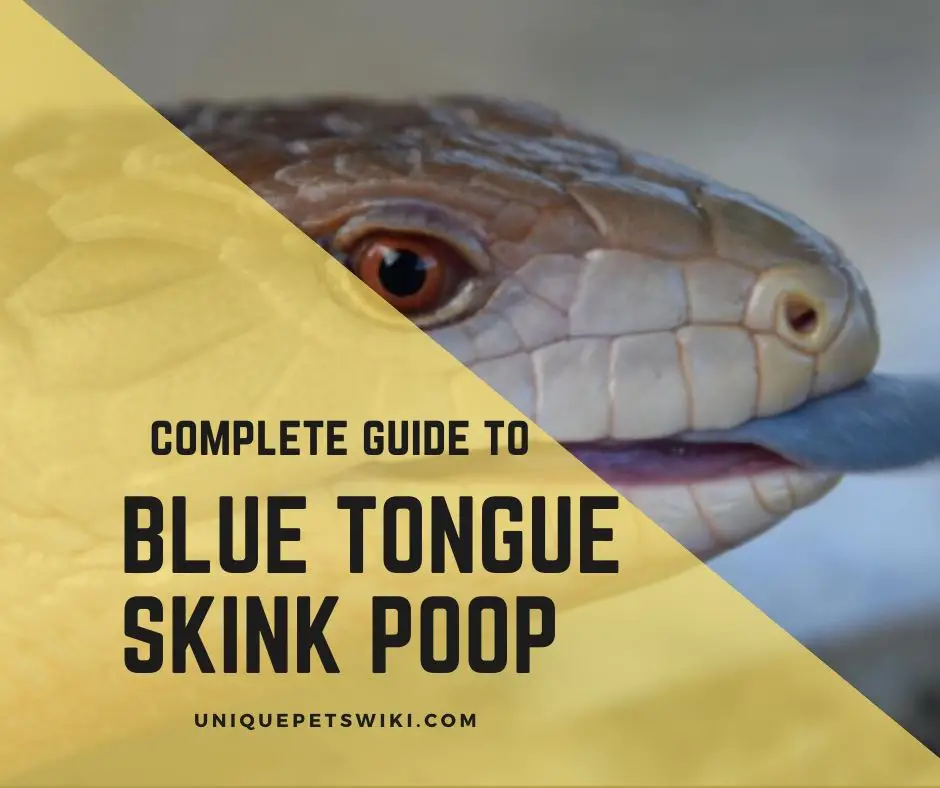Understanding blue tongue skink poop– its color, smell, and what to do if something goes wrong is an integral part of its care. But keep in mind, blue tongue skinks being reptiles should have odor-free poops.
After all, how much are their poops that would cause a panic? I bet while picking your skink as a pet, you didn’t consider its poop as something to ever worry about.
But hey! What’s that smell around your house? Your skink is pooping blood, excreting smelly poops, pooping quite often, or not pooping at all?
Then this article is for you. Read on to find answers to all the perplexing questions about your blue tongue skink poop.
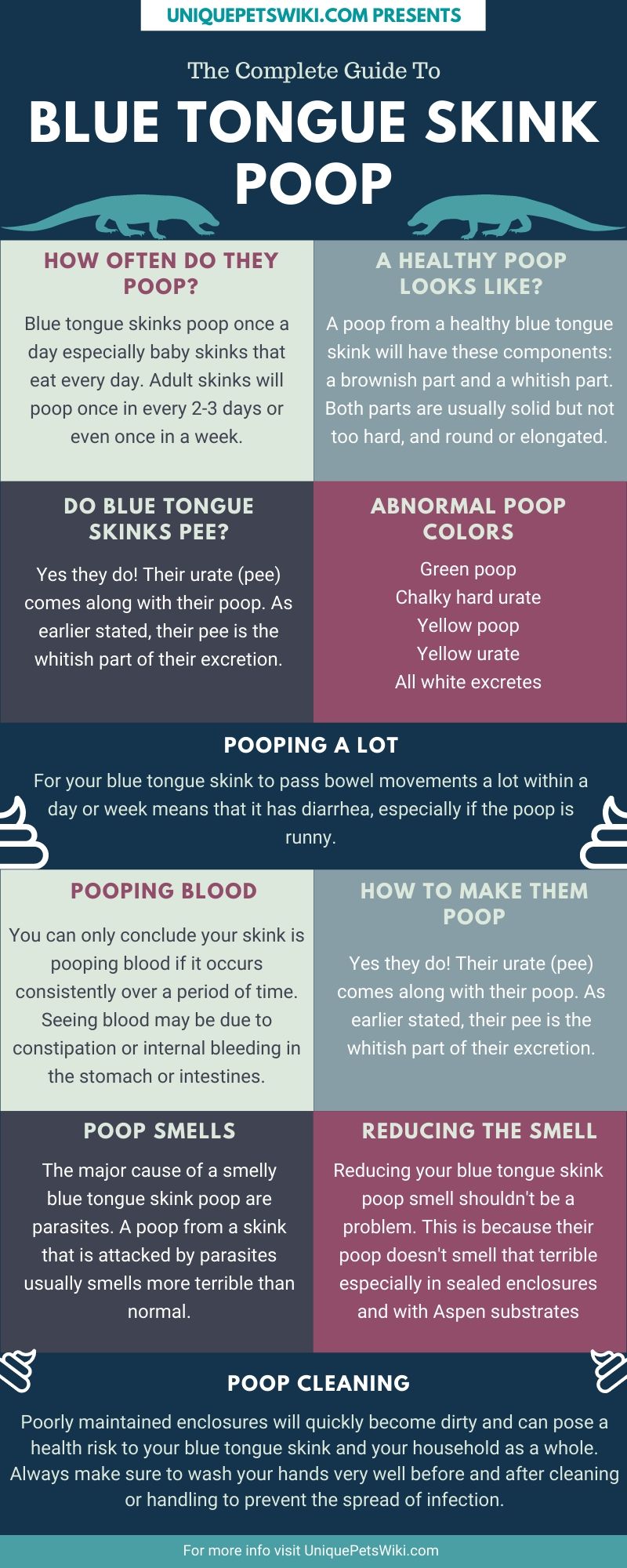
This article has been reviewed by Dr. Dilber. Read more about our knowledge control process here.
Contents
- How Often Should A Blue Tongue Skink Poop?
- What Does A Healthy Blue Tongue Skink Poop Look Like?
- Do Blue Tongue Skinks Urinate?
- Abnormal Blue Tongue Skink Poop Colors
- What If Your Blue Tongue Skink Is Popping A Lot?
- What If My Blue Tongue Skink Is Pooping Blood?
- How To Make Your Blue Tongue Skink Poop
- Why Does Blue Tongue Skinks Poop Smell So Bad?
- How To Reduce Blue Tongue Skink Poop Smell
- How To Clean Blue Tongue Skink Poop
- Conclusion
How Often Should A Blue Tongue Skink Poop?
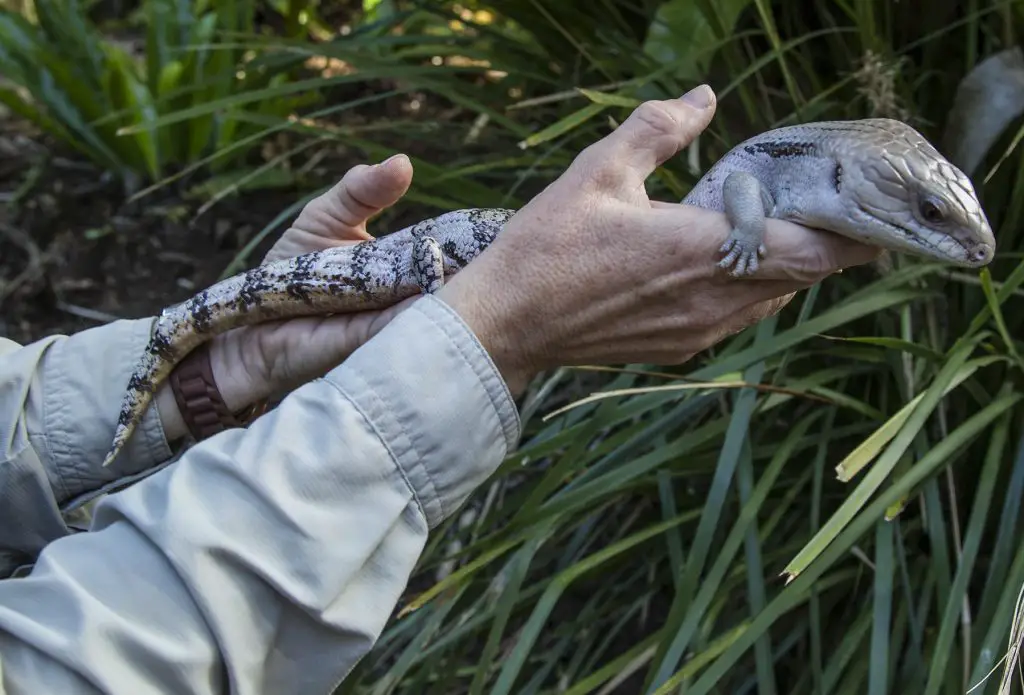
Do you mean how many times blue tongue skinks poop in a week? Or how often after eating a meal?
Let’s continue reading
Read on! We’ll answer both.
Do not expect to be told an exact number of times your blue tongue skink will poop in a week after eating or how soon it will come. This varies a lot.
Every skink is like an individual who has its own activity level and also varying conditions in which it lives. That makes it difficult to tell how long after eating, a skink will poop.
Some reports by members of the blue tongue skink Community online claimed to have “potty trained” their skinks. To date, these claims have not been scientifically or medically proven.
So we will be right to conclude that those breeders who claimed to have “potty trained” their skinks; only have understood the skink’s consistent indigestion and activities.
Perhaps the consistency of those behaviors as observed by their respective owners is what they took to be “potty trained”.
In the course of our research, we have come across various kinds of skinks who show a significant difference in behavior with other skinks.
Some skinks can hold their poop until it gets to wherever their potty is. We have come across other sets of skinks who prefer to poop on a certain spot (like the basking spot).
We have also seen skinks who poop 12 to 24 hours after eating, while others poop immediately after eating. But like I said, It varies with activity levels, temperatures, and habits of individual skinks.
My advice here is to observe your skink and understand what pattern it prefers. I am talking about how often in a week.
Adult blue tongue skinks aren’t fed every day so you shouldn’t expect excrement every day or several times in a week.
But as long as some food is consumed it would be good. However, there should be a corresponding excretion and it’s only normal that you get worried after a week or more of no excretion.
In general, blue tongue skinks poop once a day especially baby skinks that eat every day. Adult skinks will poop once every 2-3 days or even once a week.
Evaluate your skink’s husbandry should your skink go longer without pooping:
- What substrate are you using for your skink?
- Does your blue tongue skink have enough fresh water to drink? (what I mean here is how much water does your skink drink?)
- What does your skink’s diet look like?
If you can genuinely evaluate your skink’s husbandry, I believe you should figure out the problem.
New to blue tongue skink? Check out the blue tongue skink care sheet now! We had listed out all the things you need to know about blue tongue skinks as pets. Check it now!
So what should you do if your skink goes longer than a week without pooping? I advise you to feed it semi-boiled egg and banana. These two foods usually get skinks to poop.
However, if that doesn’t work for your skink, try a 10 to 15-minute bath in lukewarm water (never forget that warm underbelly heat stimulates them to poop). Bluetongue skinks need heat to digest food, therefore, they need heat to poop.
What Does A Healthy Blue Tongue Skink Poop Look Like?
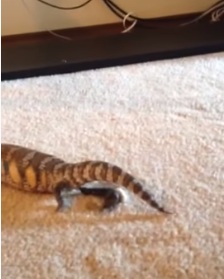
(Source: Mason Buckmayer YouTube)
A poop from a healthy blue tongue skink will have these components: a brownish part and a whitish part. Both parts are usually solid but not too hard, and round or elongated.
The brownish part of the poop is the digested matter (sometimes undigested matter of what you feed your skink will be excreted out here). The whitish part of the poop is the urate (urine), which is excreted after protein’s proper metabolism.
The whitish part which is the pee is usually solid in form to conserve water in the skink’s body.
Note: Please note that when your blue tongue skink defecates, both the poop and pee are going to be pasty or sticky- (it’s capable of staining or sticking to any surface it poops on). The poop only gets more solid and dry once it stays for some time.
Do Blue Tongue Skinks Urinate?
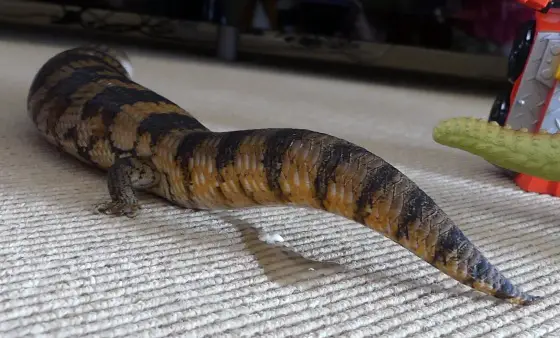
(Source: WL Fun Time YouTube)
Yes, they do. But not as dogs or humans do. Their urate (pee) comes along with their poop. As earlier stated, their pee is the whitish part of their excretion.
Blue tongue skinks have no separate excretory system organs for digestive waste material and urine. They excrete the wastes of the digestive system and kidneys in the form of poop. However, you can differentiate both types of waste as both differ in color and consistency.
If your blue tongue skink is adequately hydrated, It’s most likely to pee more often. Should you notice that your skink’s pee is hard, then it is an indication that your skink is dehydrated.
But if the urate is “chalky” in texture, then it points to the fact that there is too much calcium in its diet.
Abnormal Blue Tongue Skink Poop Colors
Let’s briefly look at some abnormal blue tongue skink poop colors and the causes.
Green Poop
For your skink’s poop to be green, it could be a dietary issue. First, evaluate your skink’s husbandry. Is your skink not getting enough dark leafy greens or not getting any at all?
Green blue tongue skink poop is a sign of high sugar in its diet. You need to decrease the fruits and increase vegetables and plants.
Is your skink’s diet a little bit high in sugary fruit than in green vegetables? If you realized that its abnormal poop color is due to its diet, you can change it.
Chalky Hard Urate
You already know from the previous section what the texture of your skink poop should feel like. Both parts (brown and white) should be soft.
However, if your skink’s white part is “chalky and hard”, it’s simply an indication that your skink has too much calcium in its diet.
Should this be the case with your skink, you only need to amend your skink’s diet. This would mean either offering it less calcium-rich foods or reducing the intake of calcium supplements.
Chalky and hard urate can also be due to dehydration. Add water and some veggies to improve this condition.
Yellow Poop or Yellow Urate
Your skink’s poop being yellow can be dietary as well. This can come from red fruits. If the poop comes with an off-color yellowish urate, it’s most likely that your skink is not having enough water and is dehydrated.
In rare and severe cases, it can be an indication of liver problems. To be completely sure, a sample of your skink’s blood will need to be tested.
All White Excretes
A normally hydrated and healthy skink should poop brown with a white urate at the tip. So an all-white poop from your skink points to “overhydration”. That on its own isn’t an issue to worry about.
However, if the whitish part of the poop is “hard” or “chalky” or off-color, then it tells you that there’s too much calcium in its diet.
What If Your Blue Tongue Skink Is Popping A Lot?
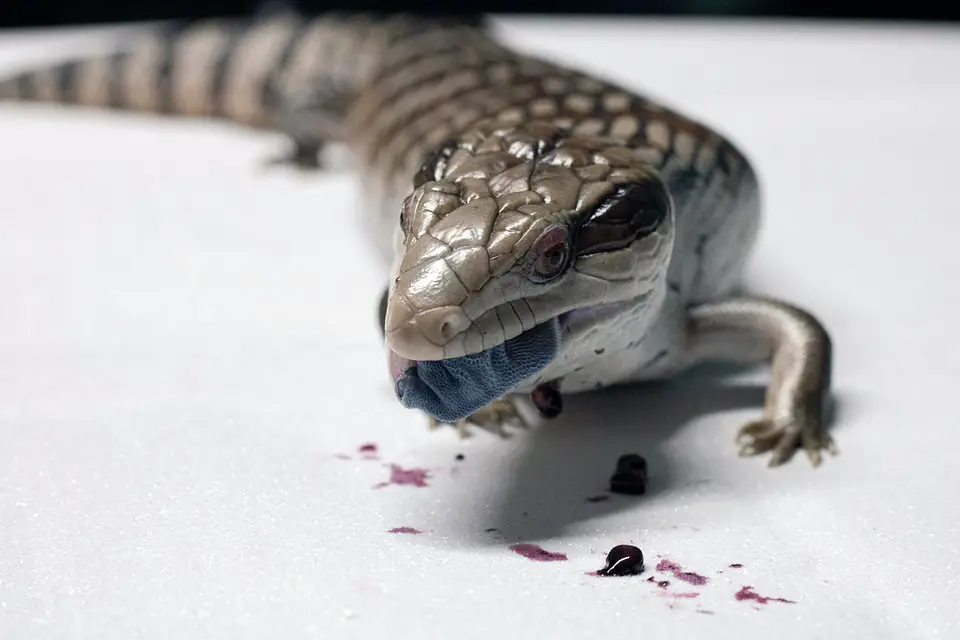
The most common causes of diarrhea in blue tongued skinks are over-hydration and parasites (often ‘coccidia’).
Overhydration is often due to feeding your skink with too many fruits, foliage greens, or hornworms.
Frequent pooping caused by parasites usually makes poop smell worse than usual. Once you notice this sign in your skink, seek medical attention as soon as possible. Prolonged diarrhea can dehydrate your pet.
What If My Blue Tongue Skink Is Pooping Blood?
You can only conclude your skink is pooping blood if it occurs consistently over a period of time. Seeing blood in your skink’s poop may be due to constipation or internal bleeding in the stomach or intestines.
If it is constipation, you’ll notice your skink appearing lethargic, rubbing its belly against the ground, and desiring to drink water. This means that the poop is stuck in the intestines.
Blood in poop is due to intestinal ulcers caused by bacterial or parasitic infections. Impaction and eating material that is too hard to digest can also cause internal bleeding.
What can you do? I advise you to give your skink lots of water to drink after which you can give it a warm bath. However, if the blood keeps occurring, then consult your veterinarian for medical check-up and treatment as soon as possible.
How To Make Your Blue Tongue Skink Poop
Before making your blue tongue skink poop, have you asked yourself why is your skink not pooping? I believe you should know why your skink isn’t pooping and what to do about it.
All right! Let’s explain that in a bit.
As long as there is an intake of food there should be a corresponding excrete of waste product for a healthy skink. So it’s normal to get worried if your skink eats but does not poop over a period of time.
Let’s find out why your blue tongue skink is not pooping.
Low Temperature
I felt there is a need to emphasize more on sticking to certain temperature requirements for your skink. Blue tongue skinks are ectothermic, so they rely on the conditions of their environment to survive.
An important fact to note is that blue tongue skinks require heat to digest their food properly and also to poop. That not being adequately provided will lead to indigestion and indigestion will in turn cause food to rot inside the digestive system.
As a result, your skink will start eating less or be unable to poop.
The ideal temperature requirements for captive blue tongue skinks are 70° F to 75° F at night and 95° F to 105° F degrees Fahrenheit with ambient temperatures of 85° F to 95° F during the day.
New to blue tongue skink? Check out the blue tongue skink care sheet now! We had listed out all the things you need to know about blue tongue skinks as pets. Check it now!
The cooling side temperature should be 70° F to 80° F for both day and night. However, bear in mind that the temperature requirements may vary depending on the size of your skink.
Always make sure that you follow the manufacturer’s instruction manual for optimum results.
Not Eating Or Drinking Enough
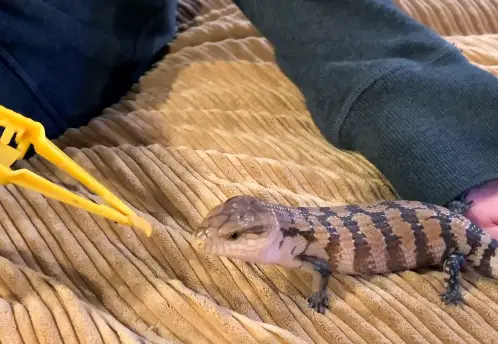
If you don’t eat or have food in your stomach, you shouldn’t be expected to poop. If this is the case with your skink, I believe what you should worry about isn’t why your blue tongue skink is not pooping; rather why is your skink not eating.
Constipation
One of the simplest ways of explaining constipation is when the intestines become filled with hardened feces. If this can happen to humans making pooping quite painful, it can also happen to your skink.
If your blue tongue skink hasn’t pooped for more than 7-10 days in a row even when meals are administered, it can be constipation. Signs that it is constipation include:
- Desire to drink more water
- Hardened belly
- Lethargy
- Rubbing the belly against the ground or other objects
Your Skink May Hide Poop
This is more common with cats, but it could even be that your skink poop is hidden among the substrates, making it hard to find.
Wrong Dieting
In one of our articles that you can find here, we discussed the impact of wrong dieting on blue tongue skinks. In there you’ll find lists of foods that are best for your skink and what you should avoid.
Wrong dieting in a way can make your blue tongue skink not poop for more than a week.
Other factors that can contribute to your skink not pooping are stress and lack of exercise and activities.
Why Does Blue Tongue Skinks Poop Smell So Bad?
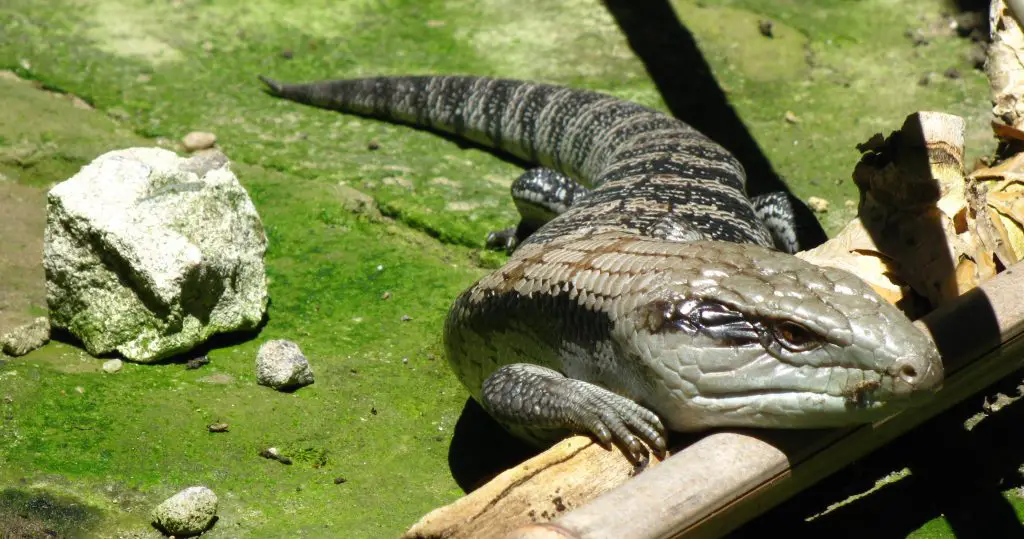
A blue tongue’s excrete consists of both poop and urine. The urine is just water and has no scent. The poop, however, is more odorous, but will not make your home odorous.
The major cause of smelly blue tongue skink poop is parasites. A poop from a skink that is attacked by parasites usually smells worse than normal.
As in humans, another possible cause of a terribly smelling poop is diet. For blue tongue skinks, some vegetables do cause extra stinky poop. Diet, bacteria, and dirt from the enclosure can also cause bad smelling of the blue tongue skink poop.
How To Reduce Blue Tongue Skink Poop Smell
Reducing your blue tongue skink poop smell shouldn’t be a problem. This is because their poop doesn’t smell that terrible especially in sealed enclosures and with Aspen substrates; or with any other substrates that can absorb the moisture.
In fact, you will not have smell issues to deal with as long as you’ve been equal to the task of cleaning its enclosure monthly or quarterly. And also regularly cleaning out any poop you find as soon as it defecates.
However, should things get out of hand; the following is what you should do:
- Undertake a thorough deep cleaning of your skink’s enclosure and accessories using a reptile safe disinfectant. This may also include changing the substrates if it’s too moist.
- Once your skink is done eating, discard any uneaten food and wash the feeder very well. This will help prevent the remnant food from decomposing. Decomposing foods, especially vegetables, always produce foul odors.
- Spot clean the substrate daily (it can be less for adult skinks)
- Make sure you’re always on the lookout for poops and clean it up immediately after it excretes or as soon as you notice it.
- Once in a while (preferably once every week) give your skink a bath of lukewarm water. Gently scrub it with a soft-bristle toothbrush with much attention given to the legs, undersides of its belly, and tail.
- Always make sure that the inside of your skink’s enclosure is kept dry. A moist substrate will give room for bacteria to thrive.
How To Clean Blue Tongue Skink Poop
Poorly maintained enclosures will quickly become dirty and can pose a health risk to your blue tongue skink and your household as a whole.
Since their droppings are often wet and are made of fecal waste and urates, both should be ‘spot cleaned’ as soon as it appears, or at most as soon as you notice it.
How do you do it?
Using your hands, or any other “clean object”, pack the excretes alongside the substrates in that region and dispose of them properly. Once you’re done, refill the substrates.
The enclosure should be thoroughly cleaned often with a safe pet disinfectant at least once a month. When doing that carefully wipe the walls, glass, and terrarium accessories.
Finally, always make sure to wash your hands very well before and after cleaning or handling to prevent the spread of infection.
Conclusion
Like other lizards, blue tongue skinks can be easily identified by their signature droppings of brown wastes and white urates on the tip.
Since skinks don’t excrement often, one may think that their excrements can never smell or give reason to be concerned.
However, many breeders have complained of their skink passing terribly smelling poop, poop with different colors than normal, frequent pooping, and not pooping at all.
Most of the bad smells are caused by bacteria and organic debris in the enclosure. If this is the case then proper husbandry will reduce the terrible smell and help keep the skink healthy.
